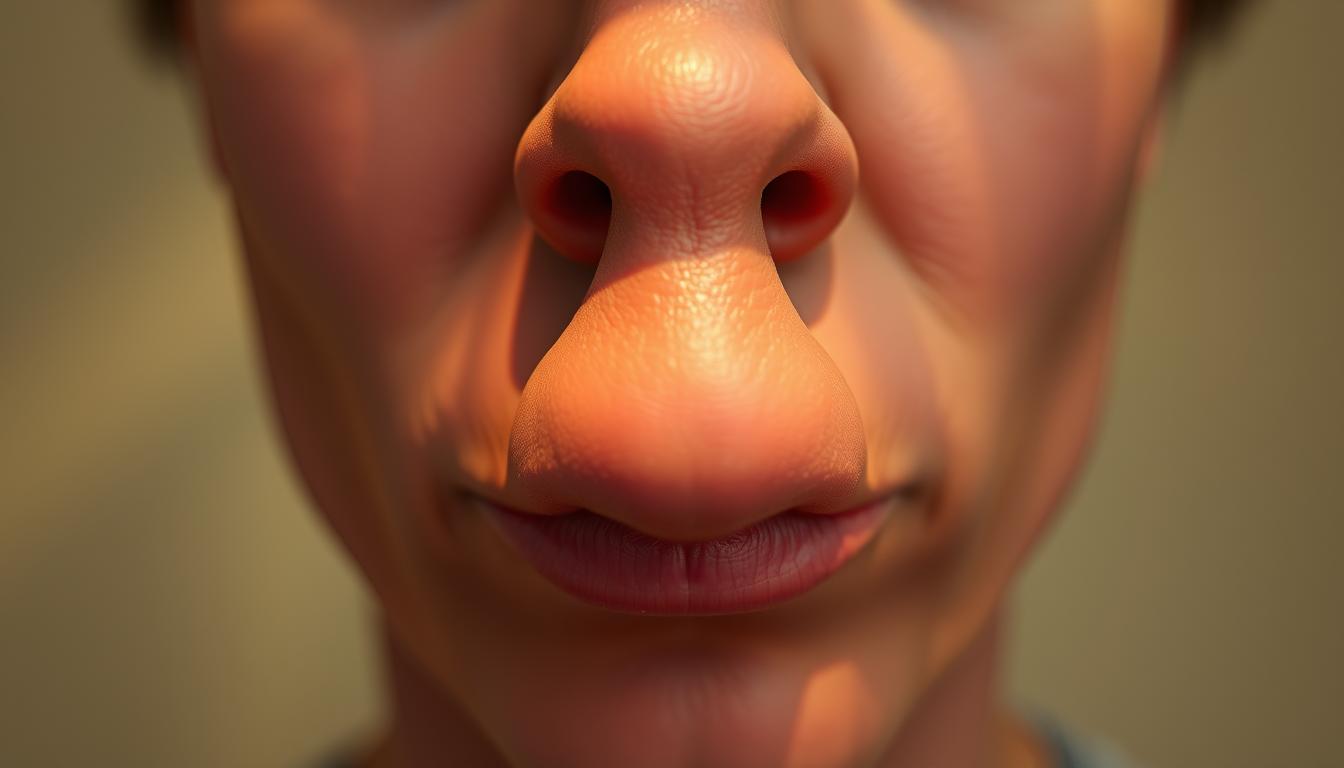A bulbous nose is characterized by a rounded, wide nasal tip, often due to thick nasal skin or large lower lateral cartilages. This distinctive feature can significantly impact facial harmony and balance.
The main issue with a bulbous nasal tip is that it draws more attention to the tip and takes away from the rest of the face. Understanding the anatomical characteristics of a bulbous nose is essential for determining appropriate treatment options.
Key Takeaways
- A bulbous nose can significantly impact facial harmony and balance.
- The condition often results from excess tissue or thick skin covering the nasal structures.
- Understanding the anatomical characteristics is crucial for treatment.
- Treatment options vary based on the individual’s nasal structure.
- Aesthetic concerns are a primary reason for seeking treatment.
Understanding Bulbous Nose
The appearance of a bulbous nose is often attributed to the shape and size of the nasal cartilages and surrounding skin. A bulbous nose can affect an individual’s self-perception and confidence.
Definition and Characteristics
A bulbous nose is defined by its rounded, enlarged nasal tip, which can result from specific configurations of the lower lateral cartilage. The characteristics of a bulbous nose include a fuller, less defined tip due to the thickness of the skin and the underlying cartilage framework.
Anatomical Features
The anatomical structures contributing to a bulbous nose involve the cartilage and skin. Key factors include:
- The size, shape, and position of the lower lateral cartilages, which directly influence the degree of bulbosity.
- The thickness and sebaceous gland content of the skin covering the nasal tip, contributing to its appearance.
- The alignment and shape of the nasal septum, which provides structural support to the nose.
Understanding these anatomical features is crucial for effective treatment planning.
Common Causes of a Bulbous Nose
A bulbous nose can be caused by a combination of factors, including genetic predisposition, injury, and certain medical conditions. Understanding these causes is essential for determining the most effective treatment options.
Genetic Factors
Genetic factors play a significant role in the shape and appearance of the nose. Individuals may inherit a predisposition to a bulbous nose from their parents, influenced by the structure and thickness of their nasal skin and underlying cartilage.
Trauma and Injury
Trauma or injury to the nose can cause a bulbous appearance due to the formation of scar tissue or the displacement of nasal structures. The severity of the injury can impact the degree to which the nose becomes bulbous.
Aging Process
The aging process can also contribute to a bulbous nose. As people age, the skin and underlying tissues of the nose can become thicker and less firm, potentially leading to a more bulbous appearance.
Skin Thickness and Medical Conditions
Skin thickness is a critical factor in the appearance of a bulbous nose. Conditions like rosacea, particularly rhinophyma, can cause significant thickening of the nasal skin and sebaceous hyperplasia, resulting in a more bulbous nasal tip.
| Cause | Description | Effect on Nasal Appearance |
|---|---|---|
| Genetic Factors | Inherited traits influencing nasal structure and skin thickness | Predisposition to a bulbous nose |
| Trauma and Injury | Formation of scar tissue or displacement of nasal structures | Bulbous appearance due to scarring or structural changes |
| Aging Process | Thickening and loss of firmness in nasal skin and tissues | More bulbous appearance over time |
| Skin Thickness and Medical Conditions | Conditions like rosacea causing thickening of nasal skin | Significant bulbous nasal tip due to skin thickening |
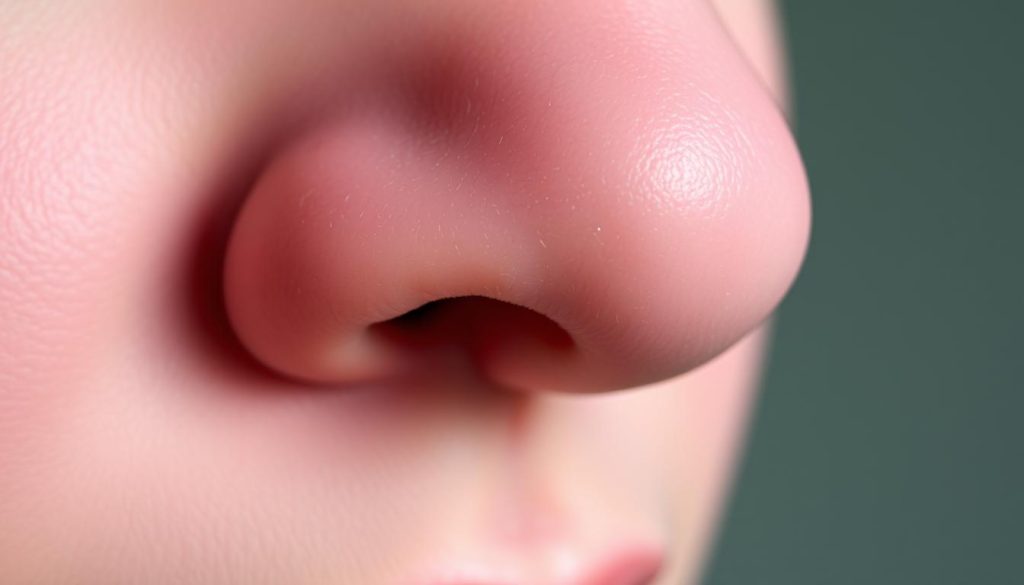
Diagnosing a Bulbous Nasal Tip
Diagnosing a bulbous nasal tip requires a comprehensive understanding of its causes and characteristics. A thorough assessment is crucial to determine the underlying factors contributing to the bulbous appearance.
Professional Assessment
A professional assessment involves evaluating the nasal tip’s anatomy, including the shape, size, and position of the lower lateral cartilages and the thickness of the skin. This assessment helps identify the primary cause of the bulbous tip, whether it’s due to excessive cartilage, thick skin, or a combination of factors.
Differentiating Between Types of Bulbous Tips
Differentiating between various types of bulbous tips is essential for effective treatment planning. The main types include cartilage-dominant, skin-dominant, and position-related bulbosity.
| Type of Bulbous Tip | Characteristics | Treatment Approach |
|---|---|---|
| Cartilage-Dominant | Excessive width or convexity of lower lateral cartilages | Cartilage modification techniques |
| Skin-Dominant | Thick sebaceous skin obscuring underlying cartilage | Addressing skin thickness or projecting cartilage framework |
| Position-Related | Normally shaped cartilages oriented to create a fuller appearance | Repositioning rather than reduction techniques |
Surgical Treatment Options for Bulbous Nose
Rhinoplasty is a highly effective surgical option for correcting a bulbous nose and achieving a more aesthetically pleasing nasal tip.
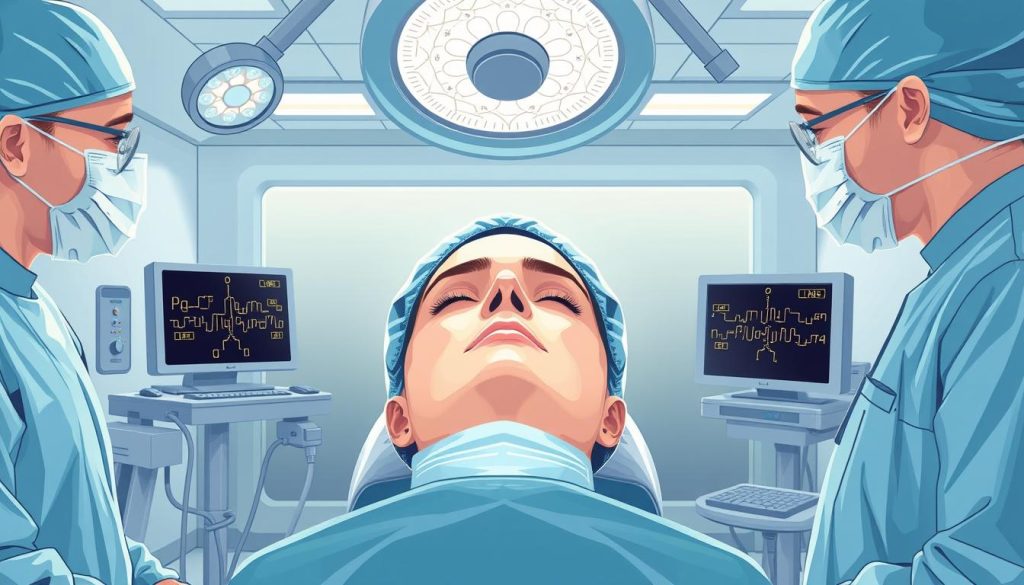
Rhinoplasty Techniques for Tip Refinement
Rhinoplasty techniques for tip refinement involve various methods to reshape and redefine the nasal tip.
Cartilage Reshaping and Trimming
Cartilage reshaping and trimming are crucial techniques used to refine the nasal tip by adjusting the shape and size of the cartilage.
Suture Techniques
Suture techniques are employed to reposition and secure the cartilage, providing a more defined tip definition.
Open vs. Closed Rhinoplasty Approaches
The choice between open and closed rhinoplasty approaches depends on the complexity of the case and the desired outcomes. Open rhinoplasty provides greater visibility and access to the nasal structures, while closed rhinoplasty involves smaller incisions and potentially less swelling.
Cartilage Grafting Methods
Cartilage grafting plays a vital role in bulbous tip rhinoplasty, particularly for patients with thick skin. Grafts are harvested from the nasal septum, ear, or rib, and are used to provide added definition to the nasal tip.
- Shield grafts create a more defined tip point that projects through thick skin.
- Onlay tip grafts provide additional structure and definition to the nasal tip.
- Lateral crural strut grafts straighten and support the lower lateral cartilages.
These cartilage grafting methods are essential for achieving a refined tip in bulbous tip rhinoplasty.
Non-Surgical Alternatives
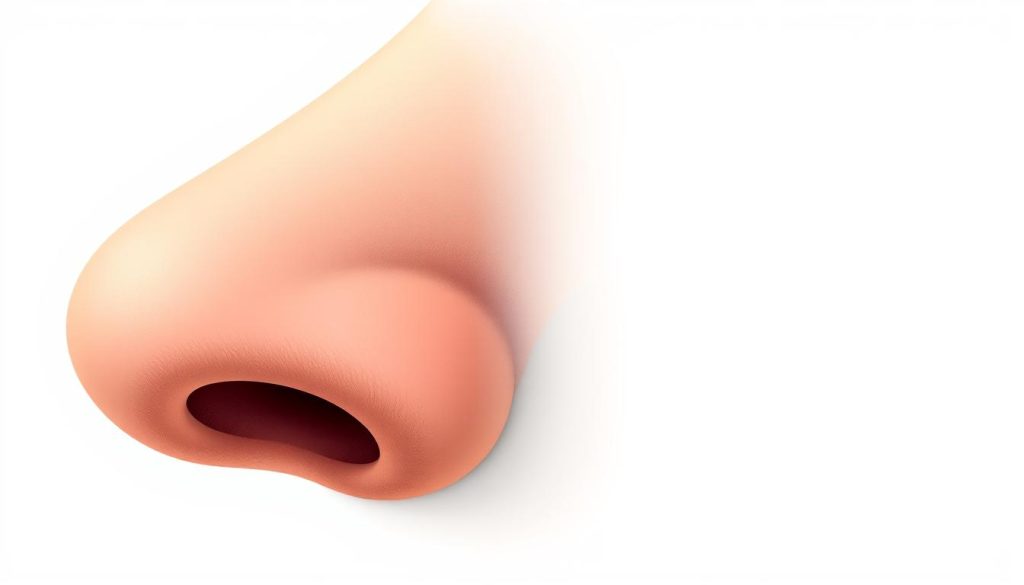
Non-surgical treatments have emerged as a popular choice for those looking to refine the appearance of a bulbous nose. These alternatives offer a less invasive approach, reducing the risks associated with surgical procedures.
Injectable Fillers and Liquid Rhinoplasty
Injectable fillers are used in liquid rhinoplasty to reshape the nose without surgery. This minimally invasive procedure involves injecting fillers to camouflage the bulbous tip, providing a more refined appearance. The quick and convenient nature of this treatment makes it ideal for individuals with busy schedules.
Benefits and Limitations of Non-Surgical Options
Non-surgical alternatives offer several benefits, including the absence of downtime and the ability to “test drive” changes before committing to surgery. However, these options have limitations, such as the inability to reduce tissue volume or reshape cartilage, making them less suitable for moderate to severe cases. Ongoing maintenance is required to sustain results, which can impact long-term costs.
The Rhinoplasty Procedure for Bulbous Nose
The rhinoplasty procedure for a bulbous nose is tailored to each patient’s unique nasal structure. This customization is crucial for achieving the desired outcome.
Pre-Surgery Consultation and Planning
Before undergoing rhinoplasty, a thorough consultation is conducted to assess the nasal tip and discuss the patient’s goals. This stage is critical for planning the procedure.
What to Expect During Surgery
During the surgery, the surgeon will make precise modifications to the nasal cartilage to refine the bulbous tip. The complexity of the tip rhinoplasty determines the extent of the modifications.
Anesthesia Options
Most patients undergoing bulbous tip rhinoplasty require general anesthesia. However, local anesthesia with sedation is an alternative for suitable candidates.
| Anesthesia Type | Description | Applicability |
|---|---|---|
| General Anesthesia | Complete unconsciousness | Most common for bulbous tip rhinoplasty |
| Local Anesthesia with Sedation | Adequate pain control with less post-operative nausea | Alternative for appropriate cases |
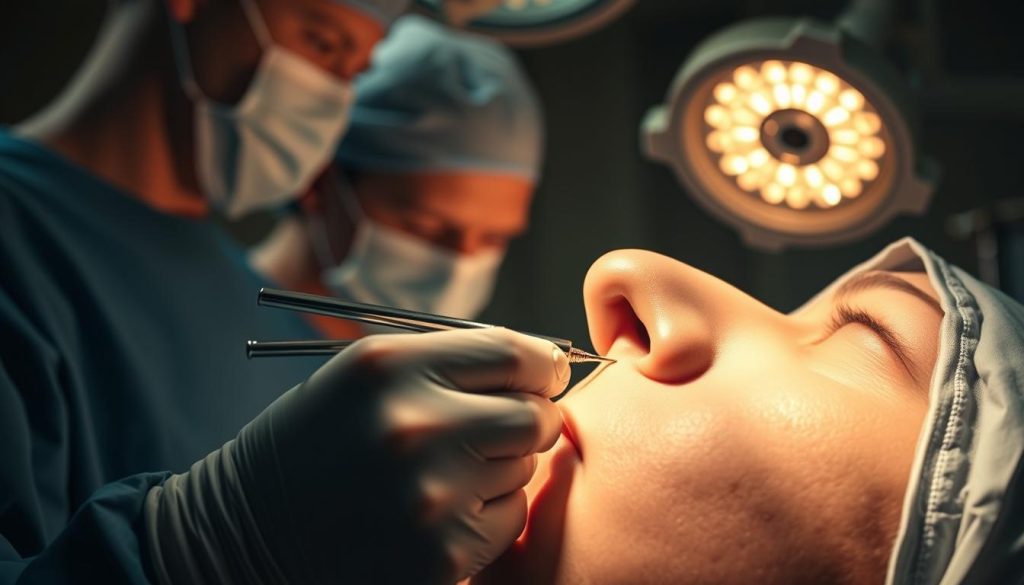
Recovery and Post-Operative Care
The recovery period following bulbous nose surgery is crucial for achieving optimal results. Proper care during this time significantly influences the final outcome of the surgery.
Immediate Post-Surgery Period
Immediately after surgery, patients are advised to rest and follow their surgeon’s instructions carefully. This includes caring for incisions and avoiding strenuous activities.
Managing Swelling and Bruising
Swelling and bruising are common after surgery. To manage these, patients can apply cold compresses and keep their head elevated. This helps reduce swelling and promotes healing.
Long-Term Care and Follow-Up
Long-term care involves protecting the nose from direct sun exposure for at least six months and avoiding contact sports for a minimum of six weeks. Regular follow-up appointments are essential to monitor healing and address any concerns.
| Care Aspect | Recommendation |
|---|---|
| Sun Exposure | Avoid direct sun for at least 6 months |
| Physical Activities | Avoid contact sports for 6 weeks |
| Follow-Up | Regular appointments with your surgeon |
By following these guidelines, patients can ensure a smooth recovery and achieve the best possible result from their bulbous nose correction surgery.
Candidacy for Bulbous Nose Correction
A thorough evaluation is necessary to determine if a patient is a suitable candidate for bulbous nose correction. This assessment considers various factors to ensure that the individual is likely to benefit from the procedure.
Ideal Candidates for Surgical Correction
Ideal candidates for surgical correction of a bulbous nose are typically those who are in good overall health and have realistic expectations about the outcome of the surgery. In some cases, ethnic rhinoplasty may be required, as anatomical variation may affect the surgical approach. Always consult with a professional to assess your eligibility.
Health Considerations and Contraindications
Certain health considerations and contraindications can affect a patient’s eligibility for bulbous nose correction surgery. For instance, patients with uncontrolled diabetes, bleeding disorders, or autoimmune diseases may require special precautions or may be contraindicated for surgery. As one expert notes, “A thorough preoperative evaluation is crucial to identify potential risks and optimize outcomes.” Key factors include:
- Active smoking, which significantly impairs healing and increases complication risks.
- Psychological factors, such as body dysmorphic disorder or unrealistic expectations.
- Previous nasal surgeries or trauma, which require careful evaluation due to potential scar tissue and altered anatomy.
- Use of certain medications, including blood thinners and some supplements, which may need to be discontinued before surgery.
Seeking Professional Treatment for Your Bulbous Nose
Achieving a more refined nasal appearance through rhinoplasty involves a combination of art and science. For individuals considering correction of a bulbous nose, finding the right surgeon is crucial. Dr. Andres Bustillo, a board-certified facial plastic surgeon, brings years of expertise in rhinoplasty, including bulbous nose correction.
To schedule a consultation, contact Dr. Bustillo’s office today. During your consultation, review before-and-after photos of previous bulbous tip corrections and discuss all available options, including both surgical and non-surgical approaches, to determine the best treatment plan for your specific concerns and anatomy.
By choosing a qualified surgeon, you can ensure a more refined nasal appearance and enhanced facial harmony. Start your journey toward confidence and aesthetic harmony with a consultation.
FAQ
What is a bulbous nasal tip?
A bulbous nasal tip is a condition where the tip of the nose appears rounded, enlarged, or bulbous due to the shape and size of the underlying cartilage and skin thickness.
What causes a bulbous nose?
A bulbous nose can be caused by genetic factors, trauma, aging, or certain medical conditions that affect the nasal cartilage and skin.
How is a bulbous nasal tip diagnosed?
Diagnosis involves a professional assessment by a surgeon or a specialist who evaluates the nasal structure, skin thickness, and cartilage shape to determine the best course of treatment.
What are the surgical treatment options for a bulbous nose?
Surgical treatment options include rhinoplasty techniques such as tip refinement, open or closed rhinoplasty approaches, and cartilage grafting methods to reshape the nasal tip and improve its appearance.
Can a bulbous nose be corrected without surgery?
Yes, non-surgical alternatives such as injectable fillers and liquid rhinoplasty can be used to temporarily improve the appearance of a bulbous nose, but these methods have limitations and may not be suitable for everyone.
What is the recovery process like after bulbous nose correction surgery?
The recovery process involves managing swelling and bruising, following post-operative care instructions, and attending follow-up appointments to ensure proper healing and optimal results.
Who is a good candidate for bulbous nose correction?
Ideal candidates for surgical correction are individuals with a bulbous nasal tip who are in good overall health, have realistic expectations, and are looking to improve the appearance of their nose.
How long does it take to see the final results of bulbous nose correction surgery?
It can take several weeks to several months for the swelling to subside and the final results of the surgery to become apparent, depending on the individual’s healing process and the extent of the procedure.
